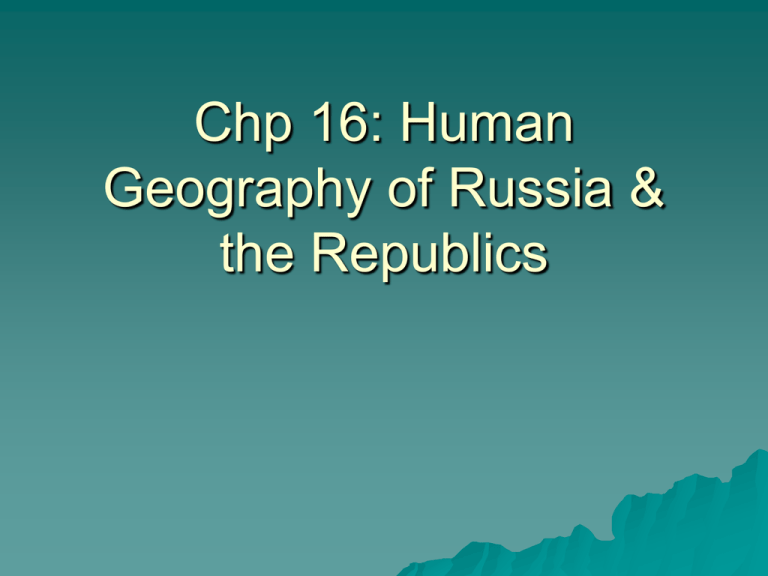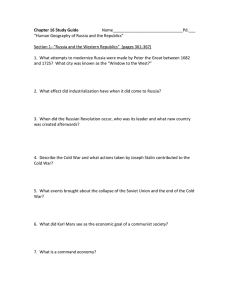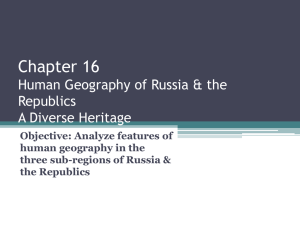Chapter 16 and 17 PPT
advertisement

Chp 16: Human Geography of Russia & the Republics In class assignment Create an ILLUSTRATED timeline of the leadership transitions of Russia Take Five… Why would Russia naturally be protected from invasion? When you think of Russia, what types of people do you think of? European? Indian? Slavic? Jewish? What future US state was swallowed up by the expansion of the Russian Empire? What is a czar/tsar? Russia and the Western Republics 800s AD Vikings establish trade and Kiev 1200s AD Tatars from Mongolia invade and sacked Kiev 1500s Ivan the Great takes control of Russia--ends foreign rule Focus on expansion/conquest Expansion of ethnic groups, languages, customs and religions Mongols Ivan the Great Ivan the Terrible… St. Basil’s Cathedral 1561 Built to commemorate the military conquest of Ivan the Great against the Tatars Ivan the Terrible had the architects eyes removed after the completion of the cathedral Take Five… Complete on pg 362 the Skill Builder questions Russia leadership Romanov family takes control of the throne 1613 Michael Romanov 1613-1645 Russia Lags behind Western Europe Science and technology lagged behind that of its European rivals Peter the Great, Czar of Russia from 1682 to 1725 New Capital – St. Petersburg aka “Window to the West” Industrial Revolution was sweeping over many Western European countries in the beginning of the 1800’s Russia’s Industrial Revolution occurred at the end of the century Peter the Great 1682-1725 Moved the capital from Moscow to St. Petersburg on the Baltic Sea Spread westernization Opened up Russia to new schools, philosophy, free press, court system etc. Catherine the Great 1762-1796 Nicholas II Last Czar of Russia Economic and military collapse WWI (1914-1918) Russian revolution Executed by Bolsheviks The Russian Communist Party lead V.I Lenin Rasputin Advisor to the Czar and Czarina Medical expert to Czar’s son-Alexis End of the Czars Vladamir Illych Lenin Organized the different peoples absorbed by Russia’s expansion New nation was called Union of Soviet Socialist Republics (USSR) or Soviet Union for short New capital – Moscow All wealth including land, industry and business was nationalized Josef Stalin, WWII & The Cold War Lead USSR in fight against Nazi Germany Relations worsen with allies Late 1940’s – tension Installed Probetween U.S and USSR Soviet leads to conflict governments Diplomats called this Spreading the Cold War due to no communism open warfare Fall of the U.S.S.R. 1989 Fall of the Berlin Wall 1985 – Mikhail Gorbachev became Soviet leader 1991 Fall of the U.S.S.R. Dismantling of former Republics— 15 independent republics Ethnic conflicts Russia – largest and most powerful Popularly elected president Legislature – Federal Assembly (2 chambers) – Federal Assembly – State Duma The Beginnings of Communism Command economy Collective farms The Cold War Economic Dream vs. Harsh Reality Karl Marx – German Philosopher In a communist society, he argued, everyone would own property together and share the wealth Economic Dream vs. Harsh Reality Command Economy – the central government makes all important decisions Government took control of major sources of state’s wealth Goal – Rapid industrialization Created enormous Collective Farms Starvation, Hunger, Death Millions of people starved to death in famines caused, in part, by the creation of collective farms People were swiftly punished for any form of protest Historians estimated Stalin is responsible for the deaths of more than 14 million people Ethnicity, Religion and Artistic Genius Rich variety of ethnic groups Great number of religions – most following Orthodox Christianity Buddhism, Islam and Judaism Golden Age of Culture Begins Orthodox Christian Churches – earliest artistic achievements Peter the Great encourages communication with Western Europe Writers – Aleksandr Pushkin and Feodor Dostoyevsky Composers – Peter Tchaikovsky and Igor Stravinsky Artists - Socialist Realism Take Five… What is a dacha & a banya? Russian Lifestyles Urban cities (Moscow & St. Petersburg) similar to Western cities – Can read books, magazines, and newspapers from all over the world – Keep up with new movies, music and clothing trends – Experience a wide variety of foods Dachas—weekend homes Banya—bathhouse rituals Dacha Banya Disaster…Chernobyl In Class Assignment… • • • Read pgs 368-369 Summarize the events of Chernobyl Summarize the effects of Chernobyl Lasting Chernobyl Effects Chapter 16 – Section 2 Transcaucasia Vocabulary Red Army Supra Pre-Lesson Objective Questions What three countries are part of Transcaucasia? How has its role as a gateway between Europe and Asia affected Transcaucasia? For how many centuries did Russia or the SU control either part or all of Transcaucasia? What is the region’s most important industry? What is a supra? Transcaucasia Republics Armenia, Georgia & Azerbaijan A Gateway of Migration Gateway between Europe & Asia – Trade routes—Black Sea region Thriving commercial regions in Mediterranean Europe Far East began on shores of the Caspian Sea – Languages 50 different peoples live in the region Arab Geographers call it Jabal Al-Alsun or “Mountain of Language” Indo-European, Caucasian & Altaic Migration brings Religion Customs, Cultures and Religions – Most follow Christian and Islam – Early arrival of these religions due to closeness to the area in Southwest Asia where the two religions began Armenia & Georgia – oldest Christian states in the world Muslim’s invaded the Caucasus and converted many Transcaucasians to Islam – Majority in Azerbaijan Conflict Not always lived together in harmony During the rigid soviet rule, tensions seldom erupted into open hostility Collapse of USSR in 1991, tensions grew into violence Civil war in Georgia Armenia fought a bitter war with Azerbaijan over disputed territory Invasion and conquest 18th century – Czar’s army starts making progress south of Caucasus Mountains. Russia 1500s – southward expansion starts Peter the Great takes Baku (Azerbaijan’s capital) in 1723 Russia annexed Georgia 1801 1828 Russia takes control of large stretch of Armenia Invasion and Conquest Cont. Late 1870’s, Transcaucasia added to Russian Empire Russian Revolution brings Transcaucasia brief period of independence - 1917 1920’s Red Army (U.S.S.R.) takes control until 1991 Painful economic and political changes – Famines (collective farming) – Political beliefs Economy of Transcauasia Agriculture—tea & fruits – Grapes/wine in Georgia Tourism Before SU control, there was little industry here Transformed from agriculture into an industrial and urban region Land of Flames Azerbaijan means “land of flames” Chosen due to the fires that erupted seemingly by magic from the rocks and the waters of the Caspian Sea Fires were the result of underground oil and gas deposits. Dividing the Caspian Sea Sea or Lake? As a sea 5 countries claim rights to resources on its borders As a lake, 5 countries must share resources equally Azerbaijan – large oil reserves off its coast Russia – few offshore reserves Critical Thinking The distinction between some geographic terms is not precise. Caspian Sea is the largest inland body of water in the world Critical Thinking Lake – 1.a. large inland body of fresh water or salt water Sea – 1.c. a relatively large body of salt water completely or partially enclosed by land – 1.d. a relatively large landlocked body of fresh water Critical Thinking In your pod, discuss whether the Caspian Sea is a lake or an inland sea and explain the basis of your opinion. Modern Day Transcaucasia Pre-Soviet rule – small percentage of Transcaucasia’s population was literate Education – 99% literacy rates under communist rule – Training a new generation of skilled workers – Prepared to undertake industrial development and modernization Hospitality Most important tradition – mealtime celebrations Example - Georgian Supra or dinner party Supra – – – – Breathtaking quantities of food and drink Begin w/a great number of cold dishes 2-3 hot courses Desserts to follow Toasts accompany the food and drink – Show respect for tradition, eloquence and the value of bringing people together Supra Post-Lesson Objective Questions What three countries are part of Transcaucasia? How has its role as a gateway between Europe and Asia affected Transcaucasia? For how many centuries did Russia or the SU control either part or all of Transcaucasia? What is the region’s most important industry? What is a supra? Chp 16 Section 3: Central Asia Kazakhstan, Kyrgyzstan, Tajikistan, Turkmenistan & Uzbekistan Trade route between China and the Mediterranean Sea (100 B.C.-1300s) – Caravan traders – Silk Road Silk Gold Porcelain Grapes, etc The Silk Road Technology Extra Credit Points… What is the “Great Game”? Imperialism Great Britain and Russia vie for control The Great Game – Russia wins (1800s) – U.S.S.R. gains control of the region in the 1920s-1991 Economy Nuclear testing – “the Polygon” of Kazakhstan – Effects of exposure Petroleum – Oil and gas reserves along the Caspian Sea – Oil fields in Kazakhstan and Turkmenistan The “new” Great Game Ethnicities U.S.S.R. exploited different ethniciities Redrawing borders Uzbeks = largest ethnic group Languages = Russian and Turkish Religion = Islam – Brought by Islam warriors Maintaining Traditions Nomadic – Yurts – Tourism peoples Yurts Assignment Chapter 16 Assessment – page 382-383 Reviewing Places and Terms (1-20) Main Ideas (1-10) Critical Thinking (1-5) Geographic Skills (1-3) GeoActivity – 10 Extra Credit Points Do the Assignment on Google Docs!! Due on Tuesday, December 8th Chapter 17 Today’s Issues Russia and the Republics Take Five… What is the major issue in Russia and the Russian republics after 1991? Former Soviet Citizen “We are floating in a zone of half lawlessness, half-law… We destroyed the old system but replaced it with nothing. There is a vacuum.” Chp 17: Today’s Issues Regional conflict – After breakup of the U.S.S.R. conflict over territory, ethnic superiority and power – Instable governments – Independence based on ethnicity Ex: Chechnya & Russia (1994-1996) Russia invades 2nd time (1999-2001) Ethnic rivalry in Georgia Nagorno-Karabakh (fighting between Armenia & Azerbaijan) – Refugees – Cost – Death Question… Do you think that diplomacy will work in this region? Why or why not? Section 2: The Struggle for Economic Reform After 1991 shifting from command to capitalist economies Lifting price controls 1992 Inflation—250% Privatization Vouchers Failure of the voucher system 1998 crash 40% impoverished Threats to the new capitalist system Organized crime – – – – The Russian mafia 40% of private co. 60% of state-owned enterprises Avoiding taxes Distance decay= 11 time zones, 89 regional governments, weak “central” government (Moscow) Vladimire Putin 2000 7 federal districts with governorgenerals In Class Assignment Look at the charts and graphs on pg 391 and answer the questions Candy Question… What happened to all of the U.S.S.R.’s nuclear weapons after 1991? The Soviet Union’s Nuclear Legacy Problems caused by the Soviet Union’s nuclear programs USSR dissolution in the early 1990’s – 15 new independent republics World Leaders were concerned with the logisitics Nuclear reactors were badly built and poorly managed Consequences of Collapse Political Tensions – Security of region’s nuclear materials became uncertain – Caused political tension between region’s leader and other nations Economic Health – Reluctance to shut down aging Soviet reactors – Steps to revive their economics Nuclear waste from other countries $21 billion in revenue over 10 years Consequences of Collapse Environmental Prospects – Angry Russian Environmentalists – 12/2000 last active reactor shut down in Ukraine – US funded treatment plant







